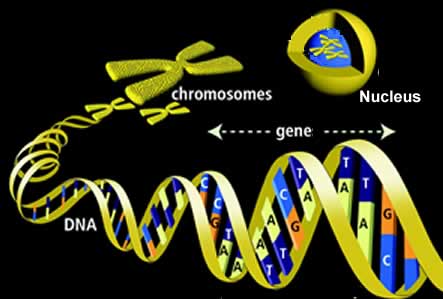To stay alive and functioning normally, the human body requires approximately a billion proteins a day. About 50,000 different types of proteins must be produced at the right places, on demand and at the right quantities. Proteins range in function and form, from the hemoglobin molecule that carries oxygen around our body, to neurotransmitters that produce movement, emotion and thought. Other proteins include eznymes which speed up chemical reactions in the cells and collagen which gives structure and support to our body. Cells are kept very busy linking amino acids in the right sequence to form the diverse array of proteins.
The genetic material of the chromosome consists of folded, coiled double helices of DNA. The genetic code is composed of base pairs in a long series of groups of three. Each group of three is called a codon and corresponds to a particular amino acid. The sequence of codons specifies not only the amino acid but also the sequence of amino acids that will form the protein chain. All the cell functions are controlled by proteins and genes control cell function through the synthesis of specific proteins.
Click for more information on proteins.


The original instructions(DNA) of the cell are too important to have floating around the cytoplasm where they can be damaged by proteins. Messenger RNAs, are made and travel to the ribosome where proteins a formed and the mRNA template is digested by enzymes when protein synthesis is complete.. The process of decoding the mRNA into a protein is called translation.
Messenger RNA is formed when the DNA unzips at a specific point along its length. One strand of the double helix acts as a template for the formation of the mRNA. Specific pairing of molecules(bases) occurs. Base pairing occurs as follows.
Adenine base on the DNA attracts the uracil base and determines its position on the mRNA.
Thymine base on the DNA attracts the adenine base and determines its position on the mRNA.
Guanine base on the DNA attracts the cytosine base and determines its position on the mRNA.
Cytosine base on the DNA attracts the guanine base and determines its position on the mRNA.